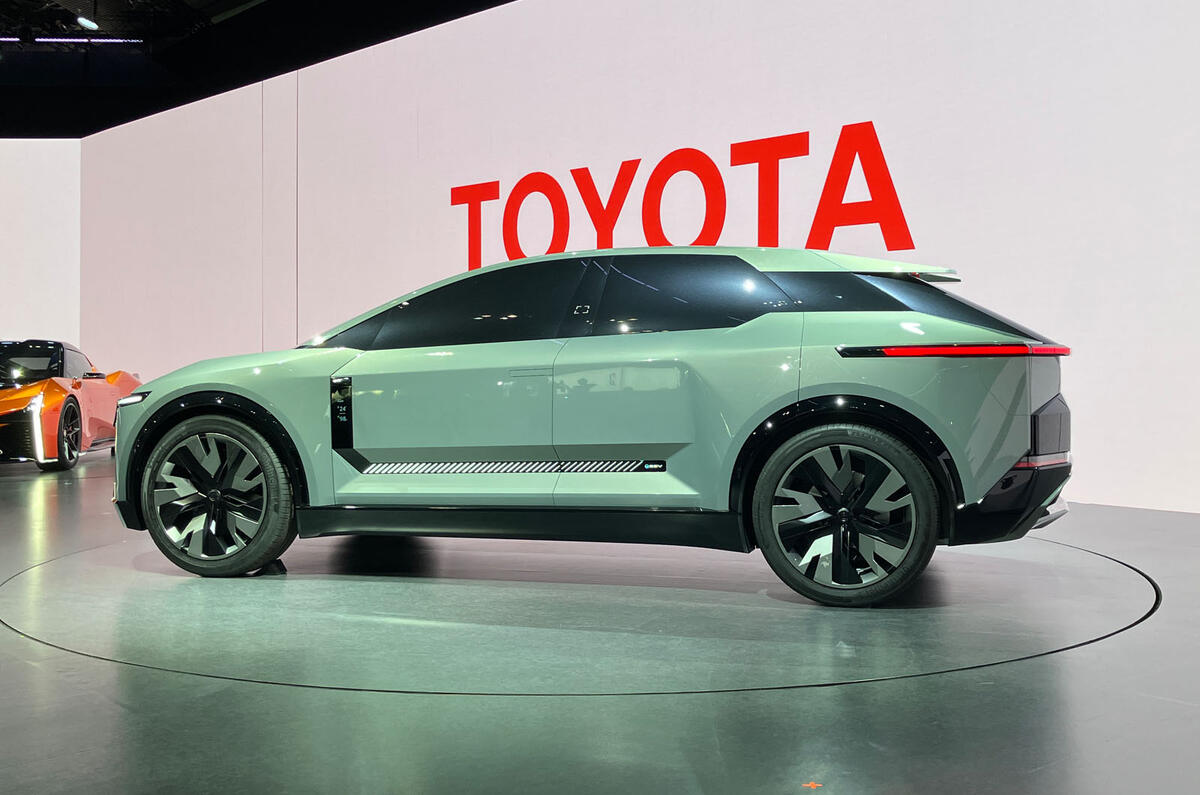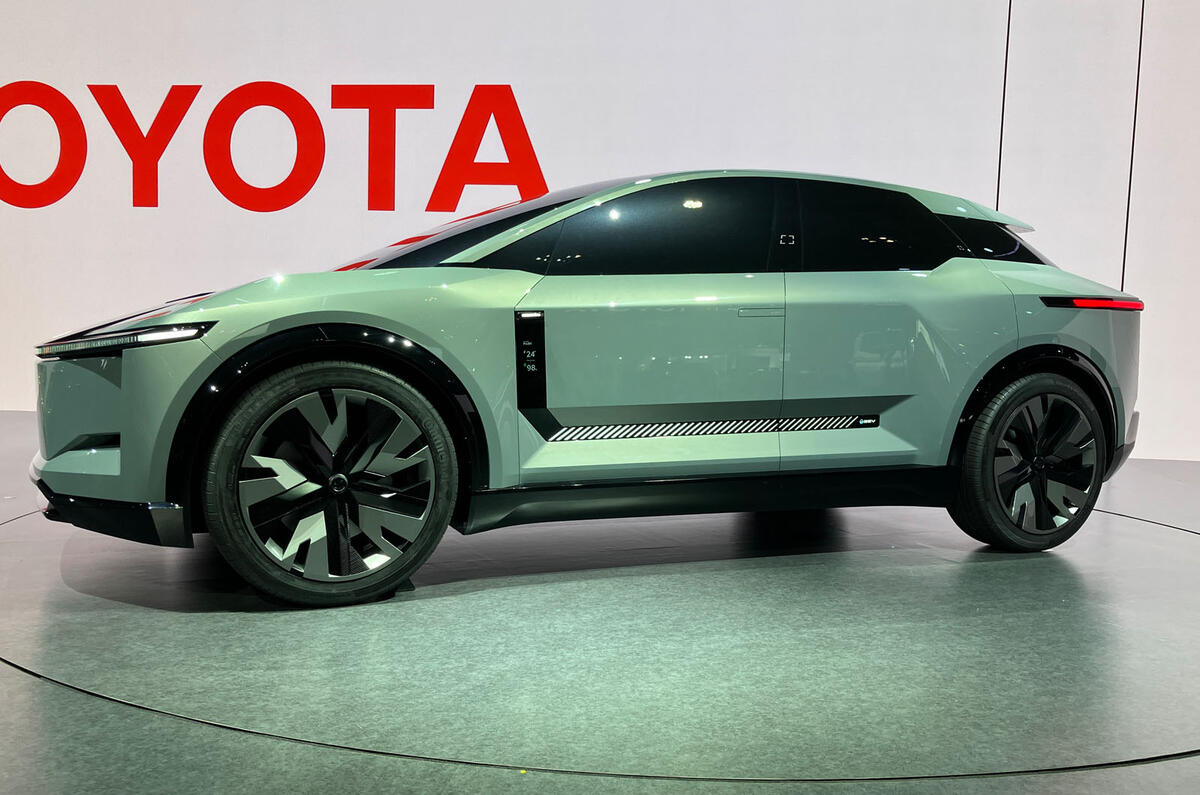Toyota has previewed its second electric SUV with the FT-3e concept, a car that paves the way for a radical electric 4x4 set to introduce a new era for the brand where it will “go beyond providing physical transportation tools".
Unveiled alongside the FT-Se sports car concept at the Tokyo motor show, it is a sharply styled five-seat 4x4 with a design language that builds on the Toyota bZ4x's.
According to Toyota, its eye-catching design has been created with the help of AI and is said to be "as simple as possible", with clean, aero-optimised lines and a prominent belt line in the same vein as the Land Rover Defender. It will also feature a bumper-width rear light bar, squared-off panelling and a new design of alloy wheel in the same colour as the bodywork.
Outside, digital displays run from the foot of the wheel arch upwards toward the door mirror. These provide the driver with information when they walk up to the car, such as the battery charge state, cabin temperature and air quality. It also gets its own light pattern along the door sills, which is expected to be unique to Toyota's electric SUVs.
The car sits on the same modular platform as the FT-Se, the Lexus LF-ZL and the Lexus LF-ZC, which allows for a “low centre of gravity” without sacrificing range, performance or – and crucial for an SUV – interior space.
The FT-3e is 4860mm long, 1955mm wide and 1595mm tall, with a large wheelbase of 3000mm.
A big feature for cars that sit on this modular electric architecture is the flexibility it offers (size, shape and powertrain layout) because of the way it is constructed. The vehicles are split into three parts (front, centre and rear) using a new gigacasting production process that allows for more freedom of form.
Notably, during production, the vehicles will move autonomously along each stage of the "self-driving assembly line" using their own battery and motor.
Speaking at the launch, Toyota CEO Koji Sato said that thanks to this platform, the brand’s next generation of cars is going to focus on “both a low centre of gravity and a spacious interior”, something that “was not possible in the past”.
He added. “To do this, we need to make the main components much smaller and lighter and deploy our strength as a car maker to put them together in the best package possible.
“Achieving this means that the design, the driving feel and everything else can be transformed.
“[We are] revisiting the fundamentals of car making and delivering based on performance, like driving range.”
The push for a lower centre of gravity to optimise its aerodynamics, and therefore an increased range, comes from Toyota’s next generation of battery technology.
The firm said reducing the height of the battery is a key factor for improved efficiency, because this in turn allows for a lower, more aerodynamic design that reduces drag. In today’s bZ4X, the battery is around 150mm tall, but that will be reduced to 120mm for this model.
Sato said: “Toyota and GR-brand cars will change. If we have the technology to make cars smaller, lower and lighter, from sports cars and SUVs to pick-up trucks and small vans, we can create a diverse line up with outstanding qualities.
“Let’s change the future of cars".
According to the company, the vehicle has been designed as a "lifestyle parter" to make the driver's life as "stress-free" as possible, allowing them to adapt the ride quality to their preference and find out information about their local area via the infotainment screen to make it a "one-of-a-kind cherished vehicle".
A key part of this is Arene, a new software platform that “can stay up to date with the latest software and use vehicle data to speed up development,” said Sato. It will “deliver new experience and value.”
An array of apps will “transform” the use of the car, from the ability to do your shopping (details were scarce but it was hinted that you could buy items ahead of time and pick up on arrival) to using vehicle-to-grid technologies to push extra electric charge back into the grid when plugged in.
“The role of cars will be to connect to society and expand the possibilities,” said Sato. “You will create a car that is just for you. That is the next generation of electric and software-driven vehicles.”
The FT-3e will also adopt emissions-reducing production techniques and on-board technology in line with Toyota's plan to cut 35% of its carbon emissions by 2030.
When the production model joins Toyota's range, it will become its second electric SUV after the 2022-launched bZ4X and contribute to the brand's goal of selling 1.5 million EVs annually by 2026.
Details such as range are still unknown, but the firm is developing a next-generation lithium ion High Performance battery pack offering 621 miles of range to replace the Performance battery in the line-up. It will also be 10% cheaper to produce, Toyota said.
The models that will use these batteries – which will account for 1.7 million of the 3.5 million BEVs that Toyota expects to sell globally by 2030 – will also be designed to be lighter and more aerodynamic than the Japanese brand’s already slippery (but heavy) sole BEV in a bid to maximise efficiency.



